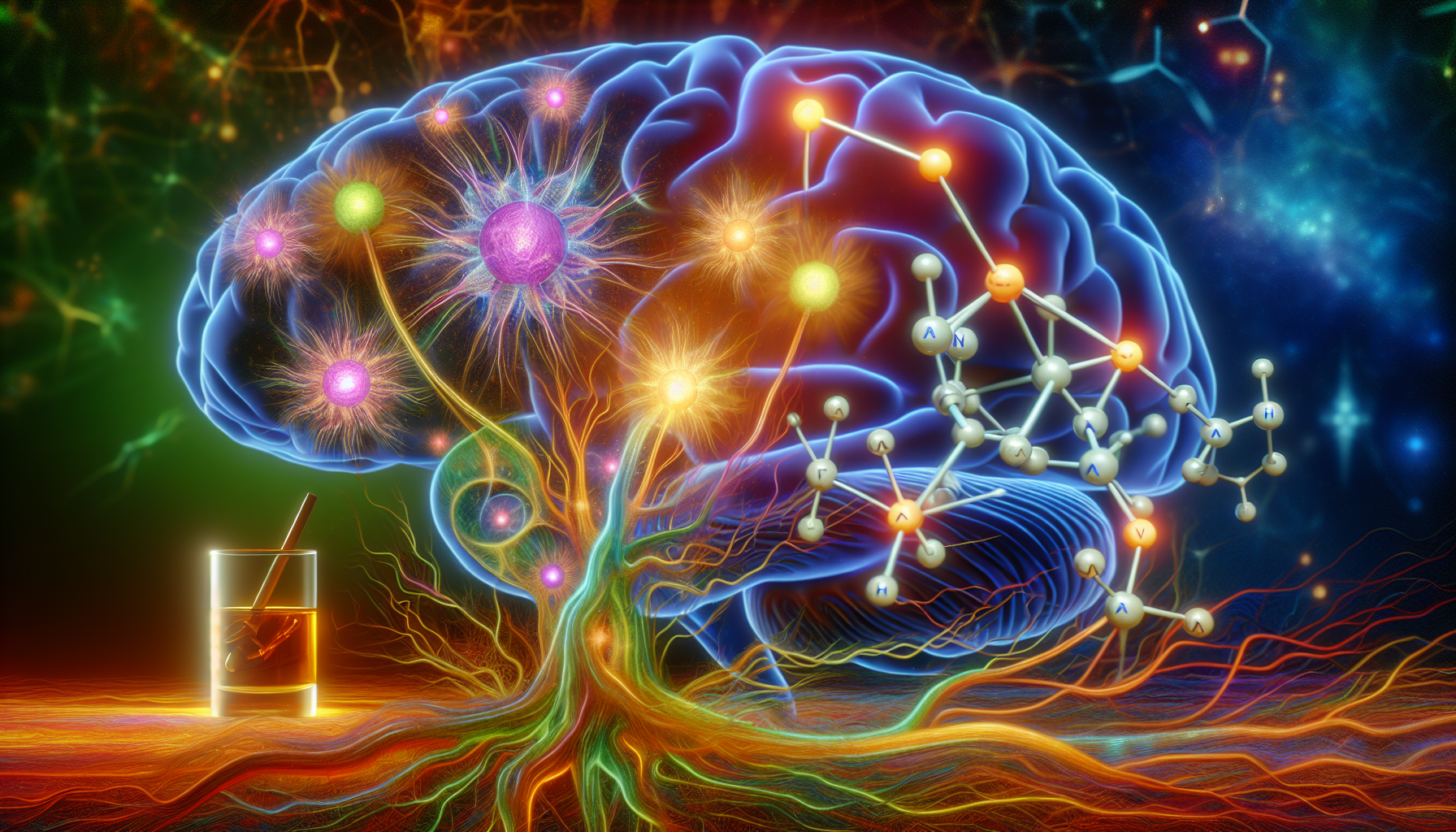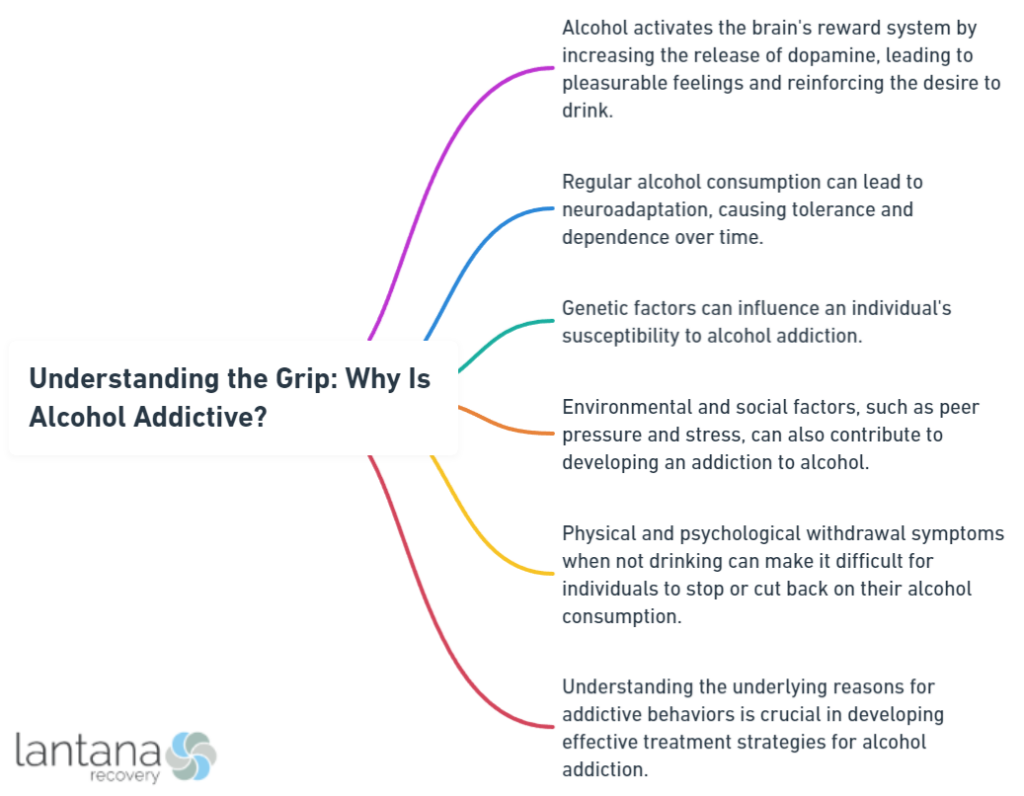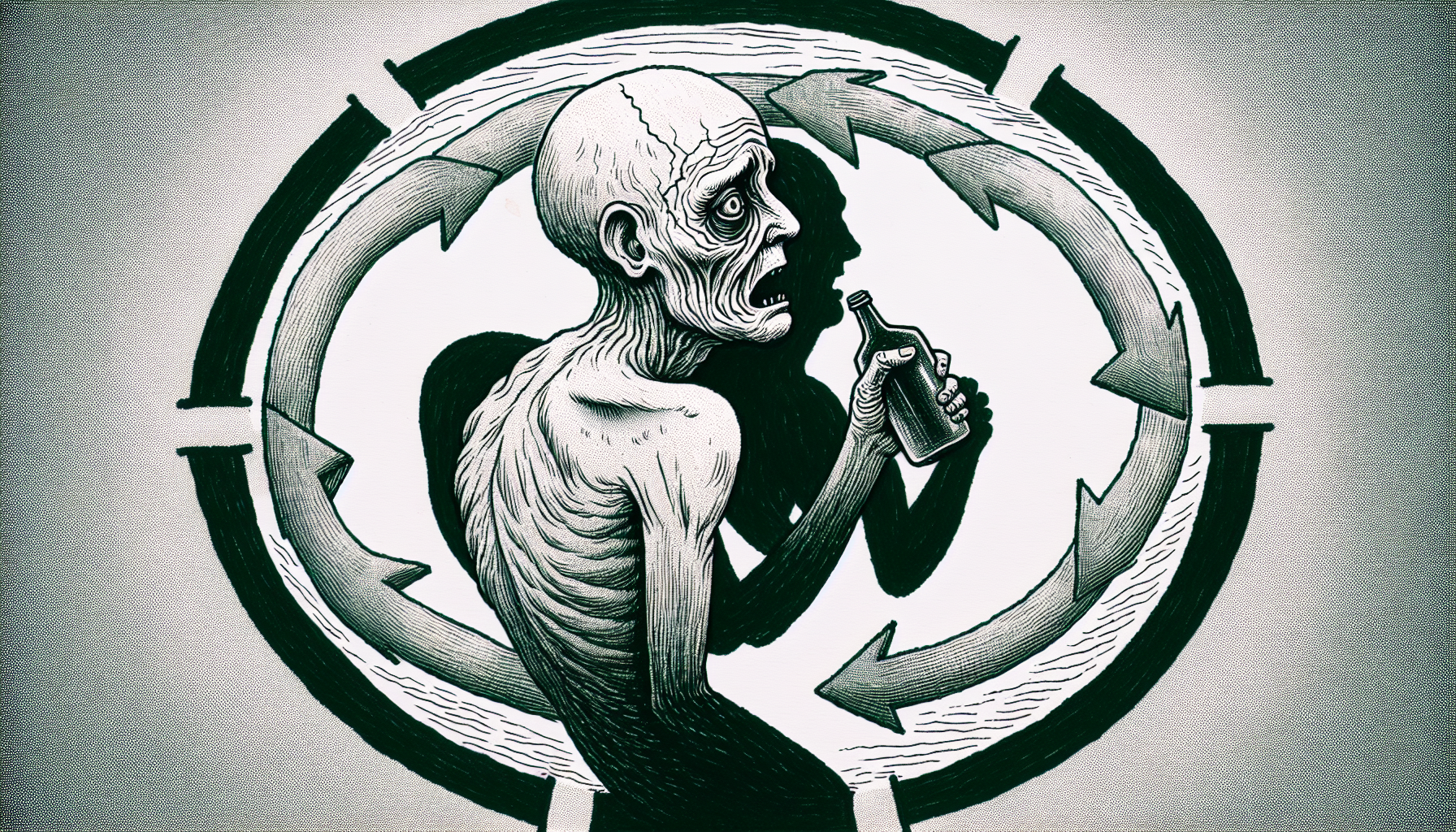Why is alcohol addictive? This seemingly simple question has a complex answer that involves the brain’s reward systems and a myriad of contributing factors. In this analysis, we dive into the neurochemical processes that make alcohol so compelling and the conditions that can escalate casual use into a compulsive need. Prepare to unravel the science behind the addiction, its progression, and the intertwined roles of genetics, mental health, and environment.
Key Takeaways
- Alcohol addiction is influenced by the brain’s neurotransmitters like dopamine, GABA, and glutamate, and also affects the opioid system, which reinforces the brain’s pleasure and reward pathways and contributes to dependence.
- Alcohol dependence develops through stages and is characterized by increased tolerance, withdrawal symptoms, changes in brain structure and function, and is often paralleled by mental health issues and social consequences.
- Risk factors for alcohol addiction include genetic predisposition, co-occurring mental health disorders, and environmental influences, while recovery necessitates professional treatment, long-term aftercare, and support groups such as Alcoholics Anonymous.
The Science Behind Alcohol’s Addictive Nature

Alcohol addiction is not a mere matter of willpower; it’s a physiological battle. The root of the problem lies in our brains and how they react to the substance. Alcohol has a profound effect on our neurotransmitters, including dopamine, GABA, and glutamate, and it influences the brain’s opioid system, which reinforces pleasure and reward pathways.
This interplay of chemicals makes alcohol addictive, forming the crux of its addictive nature.
The Role of Dopamine in Craving Alcohol
Dopamine is the neurotransmitter associated with the brain’s reward system. When we drink alcohol, dopamine is released in the nucleus accumbens, a key area involved in reward processing. This enhances the sense of reward, making the act of drinking alcohol more pleasurable.
Over time, this dopamine release creates a positive reinforcement mechanism, making the act of drinking alcohol more desirable and establishing potential cravings for future alcohol use. In other words, alcohol tricks your brain into craving more of it.
With prolonged alcohol use, the brain’s reward system becomes less sensitive to normal stimuli, leading to a state where only alcohol can trigger the release of dopamine, thus reinforcing the addiction cycle.

GABA and Glutamate: A Balancing Act Disrupted by Alcohol
GABA (gamma-aminobutyric acid) and glutamate are neurotransmitters critical to brain function. Alcohol intensifies the effects of GABA, a calming neurotransmitter, resulting in increased inhibition of neuronal signaling and producing sedative effects. This is part of what makes alcohol feel relaxing.
On the flip side, alcohol disrupts normal brain functioning by inhibiting glutamate activity at NMDA receptors, contributing to the development of dependence. As the levels of alcohol fall, the initial calming effect from increased GABA activity is followed by heightened brain hyperactivity and anxiety, which can promote further alcohol consumption.
The Opioid System: Alcohol’s Influence on Pleasure Pathways
In addition to affecting neurotransmitters, alcohol also interacts with the opioid system in our brains. It modifies the release of endogenous opioid peptides which regulate anxiety and enhance alcohol’s reinforcing effects. This interaction elevates the pleasurable feelings we associate with drinking, making us more likely to repeat the behavior.
The μ-opioid receptor is key in alcohol’s positive reinforcement; blocking these receptors can diminish alcohol consumption. But the endogenous opioid system’s reinforcement of alcohol’s addictive nature is complicated by the interaction with other systems like dopamine, GABA, and glutamate. This interplay further entrenches the cycle of addiction, making alcohol a particularly addictive substance.
Alcohol Rehab in South Carolina
Finding effective alcohol rehab in South Carolina can be a vital step towards overcoming addiction and reclaiming one’s life. South Carolina offers a range of treatment options tailored to individual needs, including residential programs, outpatient services, and holistic therapies. These facilities often provide personalized care, including medical detoxification, therapy sessions, and aftercare planning to support long-term recovery. Moreover, many alcohol rehab centers in South Carolina emphasize a comprehensive approach, addressing not only the addiction but also underlying mental health issues and life skills development. With the support and guidance of experienced professionals in a conducive environment, individuals seeking alcohol rehab in South Carolina can embark on a journey toward sobriety and improved well-being.
The Progression to Alcohol Dependence

Alcohol dependence progresses through stages, starting innocently enough with social drinking. Over time, this can escalate to habitual use, where drinking becomes a necessary part of the day. The transition is marked by signs of dependency, such as increased tolerance and withdrawal symptoms.
Heavy drinking, which often includes binge drinking, also takes a toll on brain function and behavior, further encouraging the cycle of addiction.
From Social Drinking to Habitual Use
The transition from social drinking to habitual use often starts with an increasing tolerance to alcohol. This means that over time, the same amount of alcohol has less of an effect, which leads to drinking more frequently and in larger quantities. Individuals who exhibit a greater capacity to ‘hold their liquor’ may be at increased risk for alcohol problems, as tolerance can be an early indicator of developing dependence.
Psychological traits such as impulsiveness, low self-esteem, and a need for approval can also influence this transition. Moreover, environmental factors can play a role, with peer pressure and the easy availability of alcohol contributing to an individual’s progression toward alcohol dependence.
Recognizing the Signs of Alcohol Dependency
As alcohol use becomes habitual, the signs of dependency become more evident. Physical alcohol withdrawal symptoms range from mild issues like insomnia and tremulousness to severe conditions, which may require medical intervention. Psychological withdrawal symptoms include anxiety, depression, irritability, and intense cravings for alcohol. Achieving the desired effect alcohol withdrawal requires a comprehensive approach to manage these symptoms effectively.
These signs are often accompanied by an inability to cut down on consumption, feeling compelled to drink, and being unable to refuse a drink. Dependency also often leads to neglecting responsibilities, social isolation, job loss, financial difficulties, strained relationships, and continued drinking despite recognizing its harmful effects on health and social life.
The Impact of Heavy Drinking on Brain and Behavior
The impact of alcoholism isn’t limited to physical health; it has serious implications for brain function and behavior. The effects of alcohol, especially through chronic heavy drinking, lead to changes in brain structure, such as neuron size reductions, and impair brain functions involving memory, decision-making, impulse control, and other cognitive abilities.
These progressive changes in brain structure and function can contribute to the development of alcohol use disorder, which is often challenging to overcome. Furthermore, long-term alcohol addiction frequently leads to severe mental health problems, including depression, anxiety, and a higher likelihood of suicide. These conditions can significantly impact an individual’s well-being and quality of life.
The Cycle of Addiction and Withdrawal

Withdrawal from alcohol is not a straightforward process. The cycle of addiction and withdrawal is perpetuated by the attempts of individuals to alleviate the discomfort and turmoil experienced during withdrawal by consuming more alcohol. This cycle reinforces the addiction, making it even harder to break free.
Understanding Withdrawal Symptoms
Withdrawal symptoms can range from mild discomfort to severe physical and psychological symptoms. Physical withdrawal symptoms from alcohol range from mild issues like insomnia and tremulousness to severe conditions including delirium tremens, which present with symptoms such as autonomic dysfunction and hallucinations.
The challenges during withdrawal also include intense psychological symptoms such as anxiety and depression and severe physical symptoms like nausea and possible seizures. These symptoms make professional assistance crucial for successful cessation.
How Emotional Pain Fuels the Need for More Alcohol
Emotional pain can fuel the need for more alcohol, leading to a cycle of short-term relief leading to further drinking. Consuming alcohol to cope with emotional pain, such as anxiety, depression, or stress, is often a result of psychological factors, including thoughts, beliefs, disappointments, bad moods, and boredom.
Stressful life events and adverse life conditions, such as experiences of trauma, discrimination, or poverty, often act as triggers for alcohol use, escalating the risk of developing alcohol use disorder.
Breaking the Cycle: Challenges in Quitting
Breaking the cycle of addiction is no easy task. Overcoming alcohol addiction is challenging due to brain changes, health issues, and emotional pain. Brain changes resulting from Alcohol Use Disorder (AUD) can significantly hinder an individual’s ability to stop drinking without assistance.
Alcoholism often leads to severe health issues such as liver damage and heart disease, alongside causing relationship problems and failure to meet obligations. Individuals attempting to stop drinking alcohol may relapse due to emotional pain and the challenge of sustaining personal motivation amid numerous setbacks.
Risk Factors and Personal Vulnerability to Alcoholism

The risk of developing alcohol addiction isn’t the same for everyone. There are several risk factors to consider, including genetic predisposition, mental health issues, and environmental influences. Each of these factors contributes to the likelihood of developing alcohol addiction.
Genetic Predisposition: Are You at Higher Risk?
Genetics play a significant role in the risk of developing alcohol addiction. Although there is no single ‘alcohol gene’, over 400 genomic locations and at least 566 variants have been identified that may contribute to alcohol use disorder.
Genes that affect alcohol metabolism, such as ADH1B and ALDH2, are most strongly linked to the risk of developing alcohol-related problems. A personal family history of alcohol use disorders significantly increases the likelihood of a genetic predisposition to AUD, emphasizing the role of parent-child transmission.
The Interplay Between Mental Health and Alcohol Abuse
Mental health disorders often co-occur with alcohol use disorder, with individuals using alcohol to cope with psychiatric symptoms. The most common mental health conditions that co-occur with alcohol use disorder (AUD) are:
- Depressive disorders
- Anxiety disorders
- Trauma and stress-related disorders
- Other substance use disorders
- Sleep disorders
Alcohol use disorder and mental health disorders share common genetic risks and environmental vulnerabilities such as trauma and adverse childhood experiences. Pre-existing psychiatric disorders may increase the risk of developing AUD, with individuals often using alcohol to cope with symptoms of psychiatric disorders such as anxiety and mood disorders.
Environment and Lifestyle: How They Contribute to Alcohol Addiction
Environmental factors, including family relationships, peer influence, and cultural norms, significantly shape drinking behaviors and risk of alcohol addiction. Aggressive marketing of alcoholic beverages, along with the portrayal of alcohol as a symbol of fun and social acceptability, have a substantial impact on drinking habits and the normalization of alcohol consumption.
Furthermore, the widespread availability of alcohol at social events, parties, and commercial venues presents a significant challenge to individuals attempting to abstain from alcohol, potentially triggering relapse. The environment, through various influences such as exposure to alcohol-related activities and the normalization of drinking behavior, contributes markedly to the risk of developing alcohol addiction.
What to Say to Someone in Alcohol Rehab
When communicating with someone in alcohol rehab, it’s crucial to offer words of encouragement and support. Begin by acknowledging their bravery in seeking help and express your unwavering support for their journey towards sobriety. Reassure them that you’re there to listen without judgment whenever they need to talk. Remind them of their strength and resilience, emphasizing that recovery is a process, and setbacks are a natural part of it. Encourage them to stay focused on their goals and remind them of the positive changes they’re making in their life. Let them know that you believe in their ability to overcome challenges and lead a fulfilling, sober life.
Seeking Help: Addiction Treatment Options

Overcoming alcohol addiction requires professional help. There are several treatment options available, including:
- Personalized programs
- Detox and rehabilitation
- Aftercare
- Support groups like Alcoholics Anonymous
These options cater to different aspects of addiction and provide a holistic approach to recovery.
The Path to Recovery: Detox and Rehabilitation
Detox and rehabilitation form a crucial part of recovery. The detox process typically includes an evaluation of the patient’s health, stabilization with both medical and psychological support, and preparation for subsequent treatment programs.
During the detox process, healthcare professionals use medications to manage withdrawal symptoms and ensure safety throughout recovery. Rehabilitation programs address addiction through various forms, including individual and group therapy, educational sessions on the nature of addiction, and tools for managing life post-treatment.
Aftercare and Sustaining Sobriety
The journey to recovery does not end with detox and rehabilitation. Aftercare programs and lifestyle changes are essential for maintaining long-term sobriety and preventing relapse. Aftercare programs are essential for sustaining sobriety after formal treatment and should continue long-term, with most programs recommending at least one year of active engagement.
Support through alumni and sober living home programs further strengthens the recovery process by providing coping tools and a supportive clean environment. Maintaining sobriety often involves transformative lifestyle changes such as cultivating new hobbies, forming healthy relationships, and establishing a structured daily regimen to replace old habits.
Why an Alcoholic Cannot Love
“Why an alcoholic cannot love” is a complex issue rooted in the profound impacts of addiction on emotional capacity. Alcoholism corrodes the very essence of love by hijacking one’s ability to form genuine connections. At its core, addiction fosters a self-destructive cycle that consumes both the individual and their relationships. The relentless pursuit of alcohol takes precedence over nurturing healthy emotional bonds. Consequently, the alcoholic becomes ensnared in a cycle of dependency, unable to prioritize love or maintain meaningful connections. Despite longing for love, the grip of addiction renders it elusive, leaving behind a trail of broken relationships and shattered hearts.
Alcoholics Anonymous and Other Support Groups
Support groups play a crucial role in maintaining sobriety and preventing relapse. Alcoholics Anonymous (AA), for example, provides a pivotal community-based support network with a global presence, offering over 115,000 groups worldwide that help maintain sobriety among those struggling with alcohol use disorder.
AA’s 12-step program outlines a structured recovery path with steps that include:
- Admitting powerlessness over alcohol
- Seeking help from a higher power
- Making amends for past harms
- Fostering a commitment to help others in their recovery
Regular participation in support meetings and consistent adherence to the program’s steps are key to the effective application of AA’s program and the likelihood of individuals’ recovery.
Summary
To sum up, alcohol addiction is a multifaceted issue that intertwines physiological, psychological, and societal aspects. The grip of addiction is not merely a matter of willpower; it’s a physiological battle that requires a holistic approach for successful recovery. We hope that this understanding of alcohol addiction will help you or your loved ones to seek help and take the first step towards a healthier, happier life.
Frequently Asked Questions
What are the 4 types of wives of alcoholics?
The four types of wives of alcoholics are Suffering Susan, controlling Catherine, wavering Winifred, and punitive Polly, as described by Whalen in 1983. These wives’ disturbed personalities were significant contributors to their husbands’ alcoholism.
Why are drinks addictive?
Drinks can be addictive due to their ability to cause changes in the brain’s chemistry and functioning, leading to cravings and an overwhelming desire to repeat the pleasurable experiences. The large quantities of sugar in soft drinks can also trigger addictive responses in the brain’s reward centers, leading to cravings and euphoric feelings.
How does alcohol affect the brain’s reward system?
Alcohol increases dopamine release in the brain’s reward processing area, intensifying the sense of reward and potentially leading to cravings for alcohol.
What are the signs of alcohol dependency?
If you find yourself unable to cut down on drinking, feeling compelled to drink, neglecting responsibilities, and experiencing withdrawal symptoms, these could be signs of alcohol dependency. It’s important to seek help if you notice these signs.
How does emotional pain contribute to alcohol addiction?
Emotional pain can fuel the need for more alcohol, leading to a cycle of short-term relief leading to further drinking. This can reinforce the addiction cycle for individuals coping with emotional pain.









